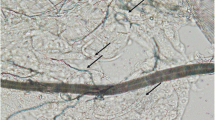Abstract
The infective larva of the spirurid nematode Habronema muscae, a parasite of houseflies, was measured and specimens fixed in Karnovsky's fluid were examined by scanning electron microscopy. The oral opening contains six teeth and is surrounded by large bilobed dorsal and ventral lips and smaller lateral lips. A pair of amphids lie behind the lateral lips. There are two rows of four cephalic papillae. The body is deeply ridged, both transversely and longitudinally. The caudal end of the worm is studded by small papillae. The position of the anal opening is somewhat ambiguous. These larval morphological features are discussed, as well as the changes which must have occurred in the metamorphosis of the infective larva to the adult in the stomach of horses.



Similar content being viewed by others
References
Carter HJ (1861) On a bi-sexual nematoid worm which infests the common house-fly (Musca domestica) in Bombay. Ann Mag Nat Hist 7:29–33
Chitwood BG, Wehr EE (1934) The value of cephalic structures as characters in nematode classification, with special reference to the superfamily Spiruroidea. Z Parasitenkunde 7:273–336
Diesing KM (1861) Kleine helminthologische Mittheilungen. Sitz Kais Akad Wiss Wien 43:269–282
Hewitt CG (1910) The house fly. At the University Press, Manchester, p 195
Krecek RC, van Niekerk JP, Els HJ (1988) A comparison of fixatives suitable for scanning electron microscopy of Habronema spp. Onderstepoort J Vet Res 55:63–65
Naem S (2007a) First description of the horse stomach worm, Habronema muscae (Spirurida: Habronematidae) by scanning electron microscopy. Parasitol Res 101:427–432
Naem S (2007b) First SEM observations on adult Habronema microstoma (Spirurida: Habronematidae), a parasite of the horse. Parasitol Res 101:743–749
Naem S (2007c) Equine stomach worm, Drashia megastoma (Spirurida: Habronematidae): first SEM report. Parasitol Res 101:913–918
Naem S (2007d) The comparative morphology of three habronematid nematodes: SEM observations. Parasitol Res 101:1303–1310
Piana GP (1896) Osservazioni sul Dispharagus nasutus, Rud. dei polli e sulle larve nematoelmintiche delle mosche e dei Porcellioni. Atti della Soc Ital d Sci Nat 36:239–262
Ransom BH (1911) The life history of a parasitic nematode—Habronema muscae. Science 34:690–691
Ransom BH (1913) The life history of Habronema muscae (Carter) a parasite of the horse transmitted by the house fly. US Dept Agric Bureau Animal Ind Bull 163:36
Schuster R, Sivakumar S, Kinne J, Heitham B, Traversa D, Buzzell G (2009) Habronematosis due to Habronema muscae in a stable in the United Arab Emirates. World Association for the Advancement of Veterinary Parasitology, Abstract Volume PO2.31, p 159
Schuster RK, Sivakumar S, Kinne J, Babiker H, Traversa D, Buzzell GR (2010) Cutaneous and pulmonal habronemosis transmitted by Musca domestica in a stable in the United Arab Emirates. Vet Parasitol (in press)
Traversa D, Giangaspero A, Iorio R, Otranto D, Paoletti B, Gasser RB (2004) Semi-nested PCR for the specific determination of Habronema microstoma or Habronema muscae DNA in horse faeces. Parasitol 129:733–739
Author information
Authors and Affiliations
Corresponding author
Rights and permissions
About this article
Cite this article
Buzzell, G.R., Tariq, S., Traversa, D. et al. Morphology of the infective larval stage of the equid parasite Habronema muscae (Spirurida: Habronematidae), from houseflies (Musca domestica). Parasitol Res 108, 629–632 (2011). https://doi.org/10.1007/s00436-010-2106-5
Received:
Accepted:
Published:
Issue Date:
DOI: https://doi.org/10.1007/s00436-010-2106-5




